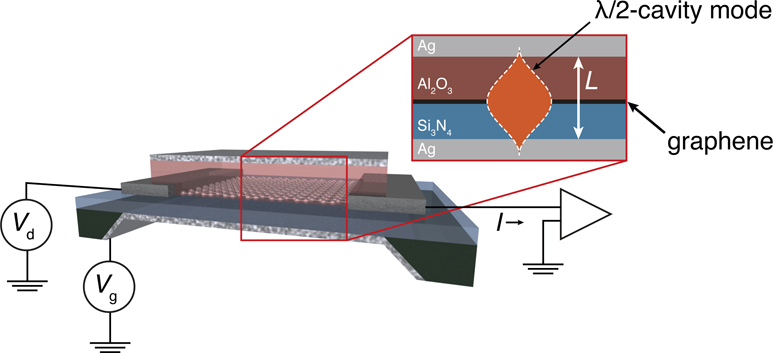The interaction between light and matter can be greatly enhanced within an optical cavity in which the spacing of two mirrors defines a standing electromagnetic wave. Placing a sheet of graphene in such a cavity can therefore have profound effects on its optoelectronic properties, as shown by M. Engel of the Karlsruhe Institute of Technology, M. Steiner of the IBM T.J. Watson Research Center in New York, A. Lombardo of the University of Cambridge, and their colleagues. Their article in the June 19 issue of Nature Communications(DOI: 10.1038/ncomms1911) describes how such optical confinement of a graphene transistor allows spectrally selective generation of photocurrent and even alters the electrical transport properties of the material.
The team embedded a sheet of graphene between two optically transparent dielectric materials, Si3N4 and Al2O3, which are in turn enclosed by silver mirrors with a spacing equal to one-half of the resonant wavelength of the cavity. At the center of this optical cavity the anti-node in the optical field enhances the absorption or emission of photons by the graphene at the resonant wavelength, and inhibits it at other wavelengths. Applying a voltage across the graphene and illuminating the device with a laser generated 20 times more photocurrent at the resonant wavelength, providing a spectral selectivity not observed in unconfined graphene. Similarly, when a current is applied to unconfined graphene, it heats up and emits a featureless thermal spectrum, whereas the graphene in the optical cavity displays a strong emission peak at the resonant wavelength.

A schematic and cross section (inset) of the graphene transistor in an optical cavity. The separation L of the silver mirrors determines the resonant wavelength λ of the cavity, for which the intensity profile of the λ/2 mode is shown in orange; V g, gate voltage; V d, drain voltage. Reproduced with permission from Nat. Commun. 3 (2012), DOI: 10.1038/ncomms1911. ©2012 Macmillan Publishers Ltd.
The researchers also found that confined graphene exhibited unusual electrical behavior. At low voltages the cavity inhibits the emission of the low energy thermal radiation with wavelengths longer than resonance, and the current therefore saturates. As the voltage is increased, this threshold for light emission is passed and the device resistance drops accordingly.
Graphene is an ideal material for this type of device because of its two-dimensional nature, which allows it to extend for micrometers across the center of the cavity, and easily tunable electrical properties. The degree of spectral selectivity provided by the optical confinement suggests a useful application in photodetection, while its influence on electrical transport could be exploited in nanoelectronic devices.




